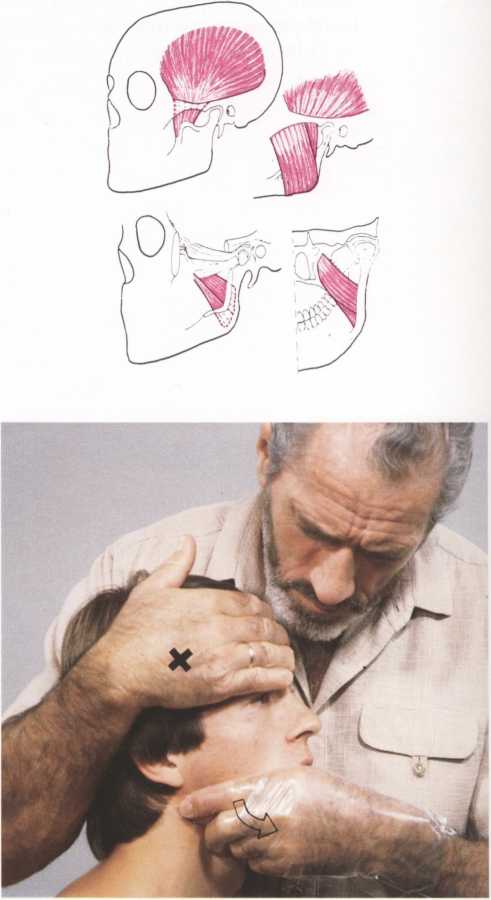90 (158)

4.2.3A. Specific technique to increase ven-tral and caudal movement of the mandible. Slight opening of the mouth.
Starting Position: P: Sitting or supine. T: Standing facing P's left side.
Grip: T's right forearm and hand grip P's head from behind. fingers against P’s forehead. T stabilizes P's head between his/her right hand, arm and chest. With medical gloved hand, Ts left thumb is placed on P’s lower molars on the right side, as far back in the mouth as possible. Ts index and middle fingers grip the angle of P's mandible on the right side with the ring and/or little fingers held under P’s mandible (depending on the size of T's hand and P’s mandible).

Fig. 72 a. Starting Position.
Procedurę: Using this grip. T applies light traction caudally to P's right TM-joint by pressing his/her thumb caudally against the lower molars while gradually and maximally pulling ventrally to produce a ventral glide of the right head of the mandible at the TM joint.
Stimulation of Antagonists: T retains grip with right hand and places left hand on the left side of P’s chin and asks P to look to the left and downwards and then move his/her mandible caudally and to the left (in the direction of stretching). T resists that movement to stimulate P’s antagonists.
Notę: If the restriction of movement is bilateral, the same treatment may be performed on P’s opposite side.

Fig. 72 b. Finał Position.
90
Wyszukiwarka
Podobne podstrony:
34 (544) 3.2.3A. Specific technique to increase ven-tral flexion of the atlas on the axis. P sitting
31 (637) 3.2.2A. Specific technique to increase ven-tral flexion of the occiput on the atlas. P sitt
32 (619) 3.2.2B. Specific techniąue to increase ven-tral flexion of the occiput on the atlas. P sitt
88 (153) 4.2.1. Specific technique to increase ven-tral glide of the mandible (j)rotru-sion). Inabil
99 (122) 5.2.2A. Specific techniąue to increase ven-tral flexion of Tl on T2. P supine. Starting Pos
42 (439) 3.3.2B. Specific technique to increase ven-tral flexion with rotation and lateral flexion t
43 (434) 3.3.2C. Specific technique to increase ven-tral flexion with rotation and Iateral flexion t
33 (623) 3.2.2C. Specific techniąue to increase ven-tral flexion of the occiput on the atlas. P supi
35 (522) 3.2.3B. Specific techniąue to increase ven-tral flexion of the atlas on the axis. P supine.
36 (519) 3.2.4A. Specific technique to increase ven-tral flexion of C2 on C3. P sitting. Starting Po
37 (498) 3.2.4B. Specific techniąue to increase ven-tral flexion of C2 on C3. P supine. ► Starting P
41 (472) 3.3.2A. Specific techniąue to increase ven-tral flexion with rotation and lateral flexion t
49 (372) 3.5.3A. Specific techniąue to increase dorsal flexion of the atlas on the axis. P. sitting.
58 (289) 3.6.1A. Non-specific techniąue to increase dorsal flexion with rotation and later-al flexio
60 (278) 3.6.2A. Specific technique to increase dorsal flexion with rotation and lateral flex-ion to
61 (265) 3.6.2B. Specific techniąue to increase dorsal flexion with rotation and lateral flex-ion to
62 (263) 3.6.2C. Specific techniąue to increase dorsal flexion with rotation and lateral flex-ion to
63 (253) 3.6.2D. Specific technique to increase dorsal flexion with rotation and lateral flex-ion to
64 (250) 3.7.1A. Non-specific technique to increase dorsal flexion with rotation to the right a
więcej podobnych podstron